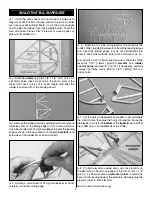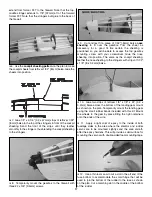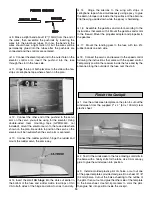
4
In addition to the equipment listed in the
“Decisions You
Must Make”
section, following is the “short list” of the most
important building supplies required to build the Li’l Poke.
We recommend
Great Planes Pro
™ CA and Epoxy glue.
❏
1/2 oz. Thin Pro CA (GPMR6001)
❏
1/2 oz. Medium Pro CA+ (GPMR6007)
❏
Hobby knife (HCAR0105)
❏
#11 blades (HCAR0211)
❏
Single-edge razor blades (HCAR0212)
❏
Small T-pins (HCAR5100)
❏
Builder’s triangle (HCAR0480)
❏
Power drill
❏
#68 (or 1/32" [.8mm]) drill bit, 1/16" [1.6mm] drill bit
❏
Small Phillips and flat blade screwdrivers
❏
Pliers with wire cutter (HCAR0630)
❏
Great Planes Plan protector (GPMR6167) or wax paper
❏
Sanding tools and sandpaper assortment
❏
Sealing Iron (TOPR2100)
❏
Double-sided foam tape (GPMQ4440) for mounting servos
❏
Hook and Loop Velcro
®
(GPMQ4480) for mounting
the battery
Here is a list of optional tools mentioned in the manual that
will help you build the Li’l Poke.
❏
Great Planes CG Machine™ (GPMR2400)
❏
Top Flite Precision Magnetic Prop Balancer
™
(TOPQ5700)
❏
Top Flite Hot Sock™ iron cover (TOPR2175)
❏
Straightedge with scale (HCAR0475)
❏
Cutting mat (HCAR0456)
❏
CA Applicator tips (GPMR6033)
❏
Great Planes 5-1/2" [140mm] (GPMR6169) Bar Sander
❏
Great Planes 11" [280mm] (GPMR6170) Bar Sander
❏
150-grit (GPMR6183) and 80-grit (GPMR6180)
adhesive back sandpaper for Bar Sanders
❏
Top Flite 320-grit sandpaper (TOPR8030) and 400-grit
sandpaper (TOPR8032)
Optional Supplies and Tools
Building Supplies
ADDITIONAL ITEMS REQUIRED
Motor System
The Li’l Poke is designed to use the Great Planes
ElectriFly T-280GD Motor System and gear drive for
electric flight (GPMG0430). This system includes a T-280
Ferrite Motor, S-280 4.1:1 ratio gearbox, 3mm prop
adapter, APC 10 x 4.7 propeller and the ElectriFly C-10
Nano High Frequency Electronic Speed Control w/BEC.
The same components are also available without the
speed control by ordering number GPMG0445.
Note:
Though the C-5 speed control is recommended,
the C-10 speed control included with the complete
system is suitable.
Battery and Charger
The ElectriFly 9.6V 350mAh NiCd pack (GPMP0070) is
recommended for the Li’l Poke.
The Great Planes ElectriFly Peak Charger (GPMM3000)
is recommended for charging this battery. It is a
peak
charger and charges the batteries until they are fully
charged, then automatically switches to trickle charge.
This charger is also suitable for nickel-metal hydride
batteries and transmitter battery packs.
Covering
There are several types of covering that may be used on the
Li’l Poke. Select a covering recommended specifically for
lightweight models. Coverite
™
CoverLite,
™
Coverite Micafilm
and Top Flite
®
EconoKote
®
are suitable. CoverLite is highly
recommended due to its light weight, with Micafilm being a
good second choice. Both materials require the application
of an adhesive such as Balsarite
™
(COVR2500) to the
structure. Top Flite EconoKote already has an adhesive on
the back so it is easier to apply, but it is also slightly heavier.
If using Coverlite, two 36" x 19.5" [915 x 495mm] packages
will be required.
Building Board
A flat building board that you can stick pins into is
required. A 12" x 24" [300 x 600mm] Great Planes Pro
™
Building Board (GPMR6946) is recommended. The back
of a 2' x 4' ceiling tile or a section cut from a sheet of
Celotex insulation board is also suitable.





































